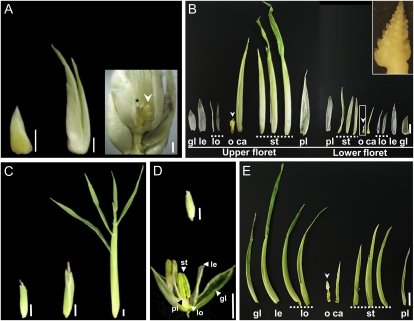Figure 5.
Loss of meristem and organ identity in spikelets of eary ears and phyllodied tassels caused by S. reilianum infection of maize cv Gaspe Flint. A, Developmental stages of eary spikelets. Eary spikelet development starts with spikelet elongation. Elongation continues but no silk emerges, and finally, two ear-like structures appear that correspond to the upper and lower florets. On the right, the surrounding husk-like leaves have been partially removed to show a new developing inflorescence (arrowhead) that also bears fungal sori (star). Bars = 5 mm. B, Manually dissected floral whorls of the eary spikelet. All the floral organs in the upper and lower florets, including the two carpels that normally form the silk, were replaced by husk leaf-like structures. The most inner whorl that normally gives rise to the ovule was transformed into a new inflorescence (arrowheads and inset). Bar = 5 mm. C, Spikelet developmental stages of phyllodied tassels. Bars = 5 mm. D, Closed (top) and open (bottom) healthy spikelets of a tassel. Bars = 5 mm. E, Manually dissected floral whorls of the upper floret of a spikelet of a phyllodied tassel spikelet. All floral organs were elongated and transformed into husk leaf-like structures, except the most inner whorl, which developed a new inflorescence (arrowhead). Bar = 5 mm. Floral organs forming in the healthy florets (D) are as follows: ca, carpel; gl, glume; le, lemma; lo, lodicules; o, ovule; pl, palea; st, stamen. In phyllodied spikelets (B and E), these abbreviations indicate the positions at which vegetative structures or new inflorescences appeared.

